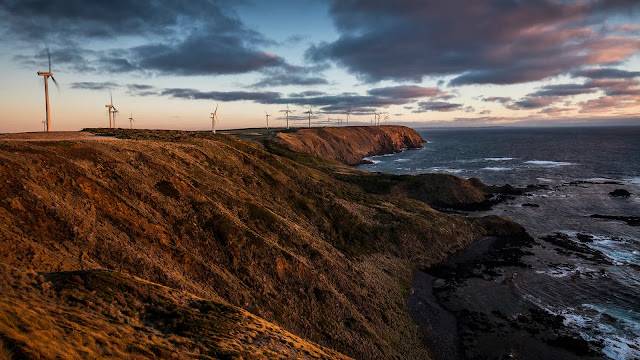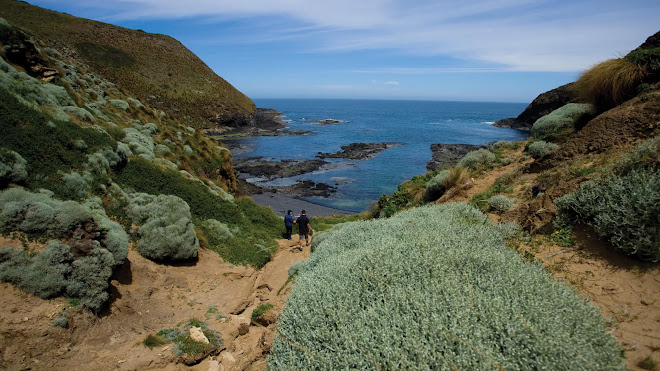Tasmania's Cape Grim: An island with the cleanest air on Earth
Image credit: Sean Scott
Venture off the untamed north-western coast of Tasmania, Australia's island state, and you'll stumble upon a remarkably remote peninsula with a foreboding name: Cape Grim, officially known as Kennaook/Cape Grim. Few travelers make their way to this far-flung region, often referred to as the "Edge of the World." But those who do are rewarded with awe-inspiring cliffs, windswept heaths, and black-sand beaches, a stark contrast to the lush farmland atop the hills.
This isolation has preserved Cape Grim's raw beauty and earned it a unique claim to fame – it boasts some of the cleanest air on Earth, as confirmed by the air pollution station perched on the cape.
Among the 25 atmospheric stations worldwide, the Cape Grim Baseline Atmospheric Pollution Station (CGBAPS), situated atop the cliffs, was established in 1976. Its purpose is to collect and analyze the composition of this pristine air, untainted by local sources of pollution such as vehicle emissions or industrial smoke.
Dr. Ann Stavert, senior research scientist at the Commonwealth Scientific and Industrial Research Organisation (CSIRO), which jointly manages the site with the Australian Bureau of Meteorology (BoM), explains, "The strong westerly winds that buffet the Kennaook/Cape Grim air monitoring station have traveled thousands of kilometers over the icy Southern Ocean, making the air measured here some of the cleanest in the world."
Cape Grim was so-named by British navigator Matthew Flinders in 1798 to
describe the terrible weather conditions he encountered here (Credit:
Paul Fleming)
The station also plays a vital role in global climate change research, tracking stratospheric ozone depletion and providing crucial weather and climate data, including temperature, rainfall, wind, humidity, and solar radiation. These measurements are pivotal in understanding how the composition of the global atmosphere is evolving.
When word got out about air samples being collected at Cape Grim, offers poured in from individuals with scuba tanks in their garages. Their contributions of air samples have created an air history dating back to 1956.
Stand atop Cape Grim's craggy peaks, and you'll be buffeted by fierce winds, reaching speeds of up to 180 km/h, carrying pristine air from Antarctica.
The waters west of Tasmania form the longest unbroken stretch of ocean on the planet, and Cape Grim marks the point where the Roaring Forties – the powerful westerly winds that sweep across latitudes 40° to 50°, making the Southern Ocean one of the most perilous on Earth – collide with the coastline after an extensive journey across the sea. This uninterrupted journey across the ocean, devoid of landmasses, results in the purest air samples on the planet.
"Using wind speed and wind direction data, we know that about 30% of the air reaching Cape Grim can be considered what scientists call 'baseline.' That is, air that is not influenced by local atmospheric sources and sinks," Stavert explains. CGBAPS also monitors "non-baseline air," which occurs when the air mass originates over Melbourne before reaching the station.
"[These samples] serve as an air archive that can be measured at a later date when new gases are discovered or new instruments become available," says Sarah Prior, officer in charge of CGBAPS. "It is just like a wine cellar but for air."
The pristine air travels over the Southern Ocean without interference from landmass (Credit: Olivia Sattler)
Other remote clean air sites around the world include Mauna Loa station in Hawaii, Macquarie Island, Casey Station in Antarctica, and the Svalbard town of Ny-Ålesund.
Tasmanian landscape photographer Olivia Sattler was drawn to Cape Grim by its fierce weather and dramatic cliffs. Despite its ruggedness, turbulent weather, and crashing waves, she notes that the region possesses a certain serenity. "There are many rugged landscapes in Tasmania, but even though I have traveled around the state photographing them, I was still blown away with how remote and rugged the Cape Grim area is – it's so beautiful and wild," she says. "The mist hovers over the waves, and when the sun sets over the water, you see amazing vibrant colors setting above the deep blues of the ocean. The fresh salty seaweed smell, rolling tussocky hills, and the way the trees are bent out of shape away from the prevailing wind makes it feel like a coastal wilderness."
Sattler also notes that the weather can be intense: "It slaps you in the face in winter, and even in summer, I would pop a cardigan on to go to the beach because it can be chilly off the water. The weather is unrelenting but it's what makes the area special."
The pristine environment in Cape Grim has inspired entrepreneurs to create a range of products, from bottled rainwater to handcrafted vodka, whiskey, and gin. There's even a local who sells bottled Tasmanian air, providing people in polluted areas around the world with a breath of pure air (each canister contains around 130 inhalations of fresh Tasmanian air).
Kennaook/Cape Grim was an important hunting ground for the Indigenous Pennemuker people (Credit: Tourism Tasmania & Kraig Carlstrom)
The north-west region is also home to some of Tasmania's finest produce. A self-drive Tasting Trail offers delectable treats like leatherwood honey from Blue Hills Honey, La Cántara artisan cheeses made from 100% Tasmanian milk, Tarkine Fresh oysters, Hursey rock lobster, and giant crab. Cape Grim beef, renowned as some of the best in the world, hails from this area.
Richard Nicholls, a local beef producer who has lived his entire life in the tiny township of Marawah, offers insights into the region's changing landscape and climate. "The landscape is forever changing in the winds, and we definitely get four seasons," he says. "It's not quite as distinct as in the past, though; they seem to roll into one another now. It's very wet, and I've only seen one or two bushfires here in my lifetime."
Nicholls describes the beauty of the area, with its ever-shifting coastline sculpted by pounding waves. He invites visitors to experience the breathtaking views from a high hill overlooking the sea. "It has to be the lushest, cleanest, and greenest place in the world."
Cape Grim beef is renowned for being among the best in the world (Credit: Olivia Sattler)
I understand Ads can be very intrusive, annoying, and capable of disrupting user's reading experience. So, for this reason I do not wish to run them on my blog. If you enjoy my post and contents and wish for me to continue and keep growing, please support me.
Buy me a Coffee! 🍵






